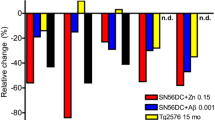Abstract
This short review discusses the arguments to consider the dismetabolism of the pathway responsible for both the maturation and degradation of NGF as the culprit of vulnerability of the forebrain cholinergic system to the Alzheimer’s disease neuropathology. This summary includes information regarding a novel metabolic cascade converting Pro-NGF to mature NGF in the extracellular space and its ultimate degradation by a metalloprotease. It also describes how this pathway is altered in Alzheimer’s disease with the consequential CNS accumulation of proNGF and impairment in the formation of NGF along with increased degradation of this key trophic factor. This metabolic scenario in Alzheimer’s disease should result in the failure of NGF trophic support to forebrain cholinergic neurons and thus explaining the vulnerability of these neurons in this neurodegenerative condition.


Similar content being viewed by others
References
Bowen DM, Smith CD (1976) Neurotransmitter related enzymes and indices of hypoxia in senile dementia and other abiotrophies. Brain 99:459–496
Davies P, Maloney AJF (1976) Selective loss of central cholinergic neurons in Alzheimer’s disease. Lancet 2(8000):1403
Whitehouse PJ, Price DL, Struble RG, Clark AW, Coyle JT, DeLong MR (1982) Alzheimer’s disease and senile dementia: loss of neurons in the basal forebrain. Science 215:1237–1239
Cuello AC, Sofroniew MV (1984) The anatomy of CNS cholinergic neurons. Trends Neurosci 7:74–78
Sofroniew MV, Pearson RC, Eckenstein F, Cuello AC, Powell TP (1983) Retrograde changes in cholinergic neurons in the basal forebrain of the rat following cortical damage. Brain Res 289:370–374
Bell KF, Claudio CA (2006) Altered synaptic function in Alzheimer’s disease. Eur J Pharmacol 545(1):11–21
Debeir T, Saragovi HU, Cuello AC (1999) A nerve growth factor mimetic TrkA antagonist causes withdrawal of cortical cholinergic boutons in the adult rat. Proc Natl Acad Sci USA 96(7):4067–4072
Goedert M, Fine A, Hunt SP, Ullrich A (1986) Nerve growth factor mRNA in peripheral and central rat tissues and in the human nervous system: lesion effects in the rat brain and levels in Alzheimer’s Disease. Mol Brain Res 1:85–92
Jetté N, Cole MS, Fahnestock M (1994) NGF mRNA is not decreased in frontal cortex from Alzheimer’s disease patients. Mol Brain Res 25:242–250
Fahnestock M, Scott SA, Jette N, Weingartner JA, Crutcher KA (1996) Nerve growth factor mRNA and protein levels measured in the same tissue from normal and Alzheimer’s disease parietal cortex. Brain Res Mol Brain Res 42(1):175–178
Hock C, Heese K, Hulette C, Rosenberg C, Otten U (2000) Region-specific neurotrophin imbalances in Alzheimer disease: decreased levels of brain-derived neurotrophic factor and increased levels of nerve growth factor in hippocampus and cortical areas. Arch Neurol 57(6):846–851
Scott SA, Mufson EJ, Weingartner JA, Skau KA, Crutcher KA (1995) Nerve growth factor in Alzheimer’s disease: increased levels throughout the brain coupled with declines in nucleus basalis. J Neurosci 15(9):6213–6221
Fahnestock M, Michalski B, Xu B, Coughlin MD (2001) The precursor pro-nerve growth factor is the predominant form of nerve growth factor in brain and is increased in Alzheimer’s disease. Mol Cell Neurosci 18(2):210–220
Harrington AW, Leiner B, Blechschmitt C, Arevalo JC, Lee R, Morl K et al (2004) Secreted proNGF is a pathophysiological death-inducing ligand after adult CNS injury. Proc Natl Acad Sci USA 101(16):6226–6230
Nykjaer A, Lee R, Teng KK, Jansen P, Madsen P, Nielsen MS et al (2004) Sortilin is essential for proNGF-induced neuronal cell death. Nature 427(6977):843–848
Bruno MA, Cuello AC (2006) Activity-dependent release of precursor nerve growth factor, conversion to mature nerve growth factor, and its degradation by a protease cascade. Proc Natl Acad Sci USA 103(17):6735–6740
Hock C, Maddalena A, Heuser I, Naber D, Oertel W, von der KH et al (2000) Treatment with the selective muscarinic agonist talsaclidine decreases cerebrospinal fluid levels of total amyloid beta-peptide in patients with Alzheimer’s disease. Ann NY Acad Sci 920:285–291
Nitsch RM, Slack BE, Wurtman RJ, Growdon JH (1992) Release of Alzheimer amyloid precursor derivatives stimulated by activation of muscarinic acetylcholine receptors. Science 258(5080):304–307
Bruno et al (2006) Alzheimer’s and Dementia. J Alzheimer’s Assoc 2(S3):S476
Acknowledgments
This work was supported by a grant from the Canadian Institutes of Health Research (MOP 62735) and a grant from the US Alzheimer’s Association (IIRG-06-25861). Dr. Claudio Cuello holds a Charles E. Frosst Merck Research Chair in Pharmacology at McGill University.
Author information
Authors and Affiliations
Corresponding author
Additional information
Special issue dedicated to Dr. Moussa Youdim.
An erratum to this article can be found at http://dx.doi.org/10.1007/s11064-007-9487-6
Rights and permissions
About this article
Cite this article
Cuello, A.C., Bruno, M.A. The Failure in NGF Maturation and its Increased Degradation as the Probable Cause for the Vulnerability of Cholinergic Neurons in Alzheimer’s Disease. Neurochem Res 32, 1041–1045 (2007). https://doi.org/10.1007/s11064-006-9270-0
Received:
Accepted:
Published:
Issue Date:
DOI: https://doi.org/10.1007/s11064-006-9270-0



